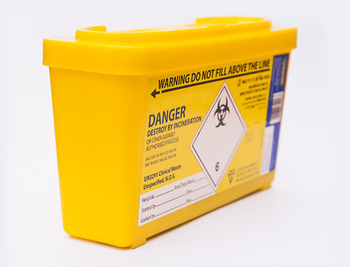Medical waste should be collected and stored prior to treatment in a way that reduces the possibility of interaction with humans (workers, patients, the public ) and the environment. Medical waste containers are generally imprinted with the universal biohazard symbol. 
Design of the collection system is an important part of medical waste management. This means defining how and when the waste goes from the initial collection point to storage and ultimately out of the facility. There are many ways to define your collection and storage systems. Keep in mind the precautionary approach.
Whose responsibility is it to collect medical waste? Everyone who works at the facility is responsible.
When it is collected, medical waste is about 150 kg per cubic meter. If you have a compactor on site, you can roughly double that before it is hauled away.
Large facilities (hospitals, research labs) may employ wheeled carts for moving waste containers around the facility. Don’t use waste carts for transport of other things. Keep transportation hardware for waste confined to waste use.
Segregating waste is a powerful technique for reducing your disposal costs and reducing risk. People resist it because it requires work up front (ideally just after the waste is generated), but the payoff usually makes it worth the effort.
To effectively segregate you need to have clearly defined categories that everyone can understand. Employees producing waste at the ground level need to know where to channel the waste - i.e. which items to put in which waste stream. Sometimes the real world will create (or at least suggest) categories for you.
It is not necessary that every health care facility use the same waste categories, but consistency is a virtue. It is a best management practice to stick with your categories and not change them often. If you are going to be a facility that recycles in accordance with your local waste authority, great! But that means you have to set up receptacles for recyclable materials and instruct your people to use them correctly.
Sorting is part of segregating. Most health care facilities sort at the point of generation, or where the waste first enters the collection system. It is usually impractical to collect your waste to a central location and then sort it. Recycling centers at the metropolitan level do that - they have huge sorting facilities. But the health care waste manager finds this impractical in most cases. Many waste managers become frustrated by the failure of employees to segregate. But it is usually too expensive to sort in a central location.
Containers for infectious waste should not be placed in public areas because patients and visitors may use the containers and come into contact with potentially infectious waste items.
Collection bins should be located as close as possible to sinks and washing facilities, because this is where most staff will deposit gloves and aprons after treating patients.
Consider putting posters on walls to remind employees to segregate according to your categories. They should always be reminded that it is the responsibility of the employee at the point of waste generation. Waste is everyone’s concern, not just the waste management professionals’.
You know the 80/20 rule that seems prevalent everywhere? It basically says a minority of the waste costs most of the money to treat. The exact breakdown might not be 80/20 - you’d have to do the calculation - but the principle is generally true in almost every facility that makes different types of waste. The consequence is that you can save money by segregating your waste.
 Different facilities have different activities and hence the optimal waste categories differ. A large hospital produces many kinds of waste and a high volume of waste. A dentist office produces a smaller volume of a more homogeneous waste. Here are some sample categories:
Different facilities have different activities and hence the optimal waste categories differ. A large hospital produces many kinds of waste and a high volume of waste. A dentist office produces a smaller volume of a more homogeneous waste. Here are some sample categories:
The categories should be established only after a comprehensive audit of the waste the facility produces. Think long and hard about the classification system.
Advantages of a large number of categories:
Disadvantages of a large number of categories:
It is common to employ red plastic bags for collection of biohazardous waste.
Be sure to maintain segregation at all times. Do not put other materials in the biohazard containers. Radioactive materials, medical devices, batteries and other products that might contain heavy metals.
Also do not include: pharmaceuticals, body parts (anatomical or pathological waste), and general non-hazardous waste (MSW). Your facility should have provisions for these materials.
IV tubing and bags should not go in these containers unless there is appreciable blood present.
Set a regular collection schedule. Have your collection personnel empty room-level waste containers into a larger container in the storage area.
Collection schedule depends on operations in your facility. A rule of thumb is that collection should happen at least once a day for MSW, every two hours for biomedical waste, every 4 hours for hazardous waste, and every two hours for radioactive waste.
If you are a large facility, consider a bookkeeping system for regulated waste, especially radioactive and RCRA hazardous waste. At some point in the collection system, define the batch of waste and give it a number. You can even print a bar code and apply it to the container.
Contamination of collection and storage containers means those containers must be managed as medical waste, too. You might be able to get multiple uses out of a container, but you won’t be able to return the container to the “clean side” and use it for non-waste materials. This is actually mandated for RCRA hazardous waste and the precautionary principle makes it a good idea for all regulated medical waste (e.g. infectious, pathological). Specifically, US federal law says containers which held hazardous waste must be triple-rinsed (filled with water three times) and the wash liquid must be managed as hazardous waste. This might allow you to re-use the container for other purposes, but it ends up creating a lot of secondary waste in the washwater. Unless the container is particularly valuable, this method is rarely used. Containers are usually disposed of with the waste they contain.
Many municipalities have occasional household hazardous waste collection days when authorities designate a place where residents bring waste from their homes. These are intended to be strictly for residential/household waste, not from commercial facilities. Different authorities have different rules, but usually these collection days explicitly prohibit biomedical waste. They are not equipped to deal with it. Check with your local government before bringing medical waste to these events.
See also: spill cleanup
Classification of medical waste types
